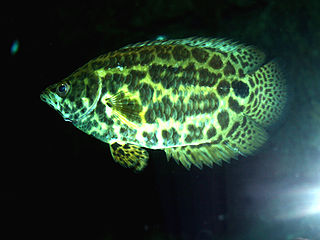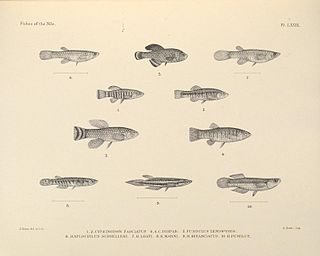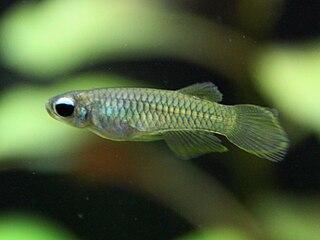
Poeciliidae are a family of freshwater ray-finned fishes of the order Cyprinodontiformes, the tooth-carps, and include well-known live-bearing aquarium fish, such as the guppy, molly, platy, and swordtail. The original distribution of the family was the Southeastern United States to north of Río de la Plata, Argentina, and Africa, including Madagascar. Due to release of aquarium specimens and the widespread use of species of the genera Poecilia and Gambusia for mosquito control, though, poeciliids can today be found in all tropical and subtropical areas of the world. In addition, Poecilia and Gambusia specimens have been identified in hot springs pools as far north as Banff, Alberta.

Rasbora is a genus of fish in the family Cyprinidae. They are native to freshwater habitats in South and Southeast Asia, as well as southeast China. A single species, R. gerlachi, is only known from an old specimen that reputedly originated from Africa (Cameroon), but this locality is considered doubtful. They are small, up to 17 cm (6.7 in) long, although most species do not surpass 10 cm (4 in) and many have a dark horizontal stripe.

Dimidiochromis is a genus of haplochromine cichlids endemic to Lake Malawi in East Africa. All of its species are elongated in shape and predatory on smaller fishes.

Barbodes is a genus of small to medium-sized cyprinid fish native to tropical Asia. The majority of the species are from Southeast Asia. Many species are threatened and some from the Philippines are already extinct. A survey carried out in 1992 only found three of the endemic Barbodes species, and only two were found in 2008. Several members of this genus were formerly included in Puntius.

The banded lampeye is a species of poeciliid that is native to Africa, ranging from Senegal to Angola. It is mainly found in coastal brackish habitats such as river mouths, lagoons and mangrove swamps. It reaches up to 7 cm (2.8 in) in total length.
Hypsopanchax is a genus of poeciliids native to freshwater habitats in Middle Africa.

Lethrinops is a genus of haplochromine cichlids endemic to Lake Malawi in East Africa. Particularly in the aquarium hobby, they are known as the sandeaters or sandsifters. Cichlid fishes of the Lethrinops genus have been studied in biology and ichthyology, primarily due to their radiated speciation and rapid evolution in their native habitat of Malawi. In biology, the speciation seen in these fish is known as explosive speciation. Numerous environmental pressures, such as overfishing, invasive species, and pollution threaten species of the Lethrinops genus. Malawi has established a national park to protect the cichlid species within the lakes.

Pantanodon is a genus of poeciliids native to East Africa and Madagascar.
The eastcoast lampeye is a species of fish in the family Poeciliidae. It is endemic to coastal Kenya and Tanzania, where found in brackish water, mangrove swamps, pools, lagoons and river deltas. It reaches up to 5 cm (2.0 in) in total length. This fish was described by Ernst Ahl as Haplochilichthys stuhlmanni with the type locality given as Tanganyika Territory. The specific name honours the co-leader of the German East Africa Expedition (1889-1892) on which type was collected, Franz Ludwig Stuhlmann (1863-1928) of the German Colonial Service.

Ctenopoma is a genus of climbing gouramies native to Africa. Microctenopoma has been included in Ctenopoma in the past; in contrast to that genus, Ctenopoma species are egg scatterers with no parental care.

Lake Dissoni, also known as Lake Soden, is a small lake in the volcanic chain in the Southwest Region of Cameroon. This volcanic lake has diameter of about 1.25 km (0.78 mi) and is at the southeastern foot of the Rumpi Hills.
Hylopanchax is a genus of poeciliids native to the Congo River Basin and Ivindo River in Middle Africa.
Lacustricola is a genus of poeciliids native to East, Southern and Middle Africa.

Micropanchax is a genus of poeciliids native to Africa.
Plataplochilus is a genus of poeciliid fishes native to Middle Africa.

Poropanchax is a genus of small poeciliid fishes native to Africa.
Rhexipanchax is a genus of poeciliid fishes native to tropical West Africa.

Procatopodinae is a subfamily of the family Poeciliidae, the "livebearers", in the order Cyprinodontiformes. Some authorities treat this subfamily as a family, the Procatopodidae, including the banded lampeye.
Aapticheilichthys is a monotypic genus of killifish from the family Poeciliidae, the sole member being Aapticheilichthys websteri. A. websteri was found by the American fish breeder Kent Webster after which the species was named. The type locality was Akaka Camp on the western coastal plain of Gabon. A. websteri was collected from a river that was less than 10m wide on the night of the Asian tsunami, though it is not clear what effect of the tsunami may have had on the local ecosystem.

Poropanchax normani, also known as the Norman's lampeye, is a species of procatopodine fish which is native to Africa. It belongs to the group of African lampeyes and livebearers (Poeciliidae).












